If you’re anything like me, you’re getting a bit of spam from “friends” and “family” today that looks like this:
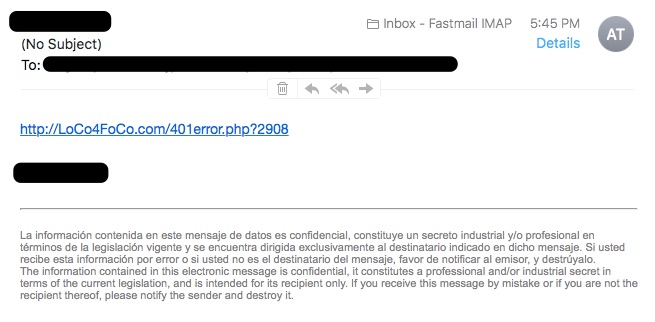
After the fourth or fifth message today, I realized there was a pattern: all of the “from” names in this spam were from people I know use Yahoo Mail as their main email account. Looking at the “from” address in the messages reveals what appears to be randomly-selected or generated email addresses that aren’t @yahoo.com, and aren’t related at all to the name.
As such I suspect what we’re seeing here is not attackers compromising Yahoo email accounts and using them to send spam, but a follow-on effect of the Yahoo data breaches of 2013 and 2014, where the contacts lists of friends and family who had me in their contacts were vacuumed out and now circulate around the Internet, associated with the original Yahoo user’s name.
As a result, spammers can send me an email that looks to me, on first blush, like it comes from my friend “Stan Zarvox,” but, in fact, has nothing to do with him. There’s a link in the mail and if I click on it, curious to know what Stan has sent me, I end up at some spammer site that may then induce me to do something that would compromise me.
Unfortunately, there’s little the poor compromised Yahoo users can do about this: things have left Yahoo’s hands now, and the email is not coming from Yahoo, nor in any way under their control.
So there’s little point in sending friends and family a “I think your account’s been hacked” warning; they probably already know 5 times over.
One of the most challenging things for families that receive funding to support their children with autism, either under the School Age Autism Funding program from the provincial Department of Education, or from the Disability Support Program of the provincial Department of Family and Human Services, is the burden of being an “employer” as far as the federal government is concerned. This means registering for a business number, making monthly payroll deductions and remittances, filing T4s at the end of the year, and preparing a Record of Employment when a employee moves on.
For many families, raising a child with autism leaves little time in the day, and navigating the paperwork jungle to do all of this correctly requires skills that not everyone has. As a result, I imagine many families are left either not receiving funding that could help them, or receiving funding but not filing paperwork and leaving themselves open to penalty if they’re found out.
So far I’ve done okay on the payroll side: it’s something I do every month for work anyway, and so it’s not a huge burden, especially because I can do the filing online through my credit union, and because the Canada Revenue Agency has a “My Business” site that’s actually quite useful and, if you set aside the “let’s recreate the flow of a 1975 PDP-11 application” style of the interface, is relatively easy to use.
Today, however, I needed to prepare the paperwork for the first employee we’ve had that’s moved on to a new job, which requires preparing a Record of Employment. You would think that all I would need to do is to login to the “My Business” system using my existing account, click a few buttons, and grab the ROE.
But no. Not that.
The Record of Employment system turns out not to be a Canada Revenue Agency system at all; it’s a completely separate application, run by a completely separate department. So it’s a completely new day in terms of online registration.
Actually, it’s worse than that.
First I needed to get a GCKey, which they tell me is a single-sign-on for many government services but that which, for reasons unknown, is not the same account I use to login to “My Business.”
Getting a GCKey required filling in a form with my name, address, and phone, and then choosing 3 security questions and answers.
But that’s only the first step.
Next I needed to use my GCKey to register for “ROE Web,” which also required providing my name, address, phone and choosing 5 security questions and answers. At the end of that process I then used the other login I have, the one for “My Business,” to tie my new “ROE Web” account to my “My Business” account.
At which point I imagined I would be able to click a few buttons and grab the ROE.
But no.
Now I see a notice on the page:
An authorization code has been mailed to the business owner or chief executive officer at the address on file.
That’s right: now I need to wait for them to mail me an authorization code. Despite the fact that I’ve created a new GCKey account, and connected it to an existing “My Business” account that already establishes me as the “business owner.”
This makes no sense.
I’m 100% down with meeting my obligations to the federal government. I enjoy paying taxes. I think taxation is fair.
But I believe that the federal government owes me, at the very least, a painless way to meet these obligations: the system we have now is cumbersome and half-baked, and has the smell of a system that no real human being with the power to affect change has ever actually used.
Who can I talk to about making this easier?
Every Friday afternoon at 2:00 p.m. Atlantic, 1:00 p.m. Eastern, my colleagues from Yankee Publishing and I have a one hour call where we review the week just passed and the week ahead (I wrote about a part of this process 7 years ago).
After all the heavy lifting is done–the prioritizing, the ticket-assigning, and so on–Alan, who handles ecommerce, will often take the floor and try to stump me on Canadian trivia questions he’s diligently gathered over the week.
I’m happy to report that I turn out to be quite successfully Canadian, at least by my success rate at answering Alan’s questions; I knew last week, for example, what a “double double” was, and that a “chesterfield” is a sofa.
By way of rewarding Alan’s devotion to highlighting my Canadianess, I decided that I should seek out a book for him before heading down to Yankee next week, and so Oliver and I found ourselves headed toward the “local interest” section at The Bookmark this afternoon.
As we approached the section, we saw that our way was blocked. But it was blocked by friends: Brenda Whiteway was in rapt conversation with Jeff Bursey. I interrupted. And then bogarted the conversation right out of Jeff’s hands and had a nice chat with Brenda. At the midpoint of which we were joined by her husband, J. J. Steinfeld. From whom we learned about new developments on the Steinfeld publishing front.
J. J. was suddenly whisked off for promotional duties, and, as Brenda and I continued to chat, I noticed my friend Mark Leggott across the room.
I said hello.
Mark said “Oh, Peter, this is certainly a book that you should buy,” pointing at a copy of Gutenberg’s Fingerprint sitting on the counter, and motioning toward its author standing nearby.
J. J. returned, and whisked Brenda off in search of lunch, and so I introduced myself to Merilyn Simonds (the author), and we had a chat about her book, a book that, she told me, details the creation of another book, produced on a letterpress.
As you can imagine, we had a lot to talk about.
One of the things we talked about was this other book, the letterpress-printed one. She pulled out a copy of it for me to page through (it is beautiful). I asked her where she’d sourced the paper, and she replied that it had come from Papeterie Saint-Armand in Montréal.
Saint-Armand, of course, is a company I know well, and of which I am a big fan; I visited, with my parents, in 2010 and we got the cook’s tour from owner David Carruthers, and I’ve purchased their excellent paper many times.
As it happens, Brenda Whiteway and I renewed acquaintance in 2014 because of David Carruthers: her search for a printer led David to connect her to me, and we went on to collaborate in service of the Confederation Country Cabinet.
Needless to say, I left The Bookmark with a copy of Gutenberg’s Fingerprint in my hand (along with a copy of You Know You’re An Islander When… for Alan) and joy in my heart.
As Paul Offer explained to me at the Charlottetown Farmers’ Market this morning, chickens do not lay eggs in multiples of 12. Which means that if you get to the market late, and dawdle, you end up with the modulo. As we did today.

We’re here at the Civic Centre for the goodbye celebration for Bruce Rainnie and Boomer Gallant from CBC’s Compass supper-hour TV news, who both retire from the CBC tomorrow. There’s a big crowd of enthusiastic fans.
Back in 2003, I blogged about the brand new Bruce-Boomer partnership on its second night on the air; I knew we were in good hands when Bruce left a comment on that post the next day:
Enjoy reading your site and appreciate your critique. Rest assured, my goal will never be to ” Out Boomer Boomer. ” That would be foolhardy.
Remember, though, it is important to be yourself on air, and if that involves an occasional pun or quip, so be it.
Some will work, some won’t, but none will be offered in competition with Boomer. He’s and Island staple, I’m an Island rookie. Keep watching, and keep the comments coming. It keeps us on our toes.
Indeed we did.
It’s been a good ride, fellas. Best wishes for the future.
 ,
,  ,
, 
I am flying to Boston on Sunday, en route to spend the week with my colleagues at Yankee in New Hampshire.
I’ve booked a car for the week from Hertz, and today I received an exciting email:
Exciting news. Hertz Ultimate Choice™ is now at Boston Logan International Airport
With Ultimate Choice, you’re free to choose the car that’s right for you. There’s no need to look for a specific number or car on the lot. Which means you can get on your way even faster, in the car of your choice.
Upgrades are available for just $35 more per day* (only $25 more per day* for President’s Circle and Platinum members). Simply select the vehicle you want to drive from the Premium Upgrade zone and go. Changes to your reservation will be completed at the exit gate.
With Ultimate Choice™, choose the car that’s right for you.
I am very particular about rental cars: I’m that guy who goes back to get a replacement car if the one I’ve given smells like it was smoked in, or has rattling parts, or if, as happened to me some years ago in Toronto when I was offered a Hyundai Veloster, I don’t actually fit in the vehicle.
I’ve had perhaps more than my fair share of random wins with Hertz over the years–a beautiful Volvo station wagon we had for a week at a midsize price, a BMW I had for 24 hours in Montreal, a Fiat 500 a few years ago in Boston–but I’m also just as likely to end up with a horrible Chevy Uglotronic as anything else.
So, in other words, I’m very excited about my new ability to pick from a litter of cars as opposed to bargaining for one.
I will report back on Sunday night as to how things went.
It’s now been three months since I decamped from the social media fields and stopped pushing notice of blog posts here to Twitter, Facebook et al.
Facebook was an easy drug to kick; Twitter was harder: for weeks, my phantom tweeting limb would conjure fully-formed witty ripostes. But I got over that too, in part by refocusing my writerly energies here on the blog.
What continues to happen, though, is that I run into friends and family, used to getting a ping from Twitter or Facebook about new blog posts; they simply assume I’ve stopped blogging (or died).
I’ve almost fallen off the wagon a few times as a result: “I’ll just push notices to Facebook and Twitter, but I’ll ignore them otherwise.” But I’ve resisted. Pringles in the top cupboard are still Pringles.
All is not unrosy, however: one of the delightful side-effects of the new world order is that I regularly get comments, corrections and cautions, in reaction to posts, from my friend Dave.
Dave, you see, has an unusual (read, “different from mine”) daily schedule that, if memory serves, sees him rising daily at 4:00 a.m., feeding the chickens, writing several young adult novels, chopping a cord of wood, and running 10 miles, all before breakfast.
But Dave subscribes to the blog by email–just like you can–and so in there somewhere he reads the previous day’s posts. And where, in an earlier day, he would have simply hit “Like”, or polished off an “attaboy” (or “what hell!?”) tweet, Dave will now send me carefully-worded emails when something strikes a chord.
This very fact alone is enough to make the decamping worth it.
So perhaps you’d like to join Dave?
You don’t have to write me carefully-worded emails. But you’ll be free from the need to ever remember again “oh, right, Peter has a blog.”
Click here to get it all started.
(You’ll get one email a day, maximum)
Swedish friend Karl needs a stencil to allow him to paint or stain the letters PJODD on stylish wooden boxes that will hold mesh wireless routers. Through the intercontinental grapevine, he heard of my 3D printing toe-dipping, and sent me a note looking for guidance. I eagerly agreed to see what I could do to help (in part, of course, because the wireless mesh he’s helping to seed is one that I will be able to connect to on my next visit to Malmö).
So here’s what I did.
First, I found a stencil font, called Gunplay, that I could use to render the letters PJODD digitally in a way that wouldn’t leave any stray “inside bits” that would fall off a 3D object.
I installed the font on my Mac, and then used Inkscape, an open source illustration tool, to render the type:
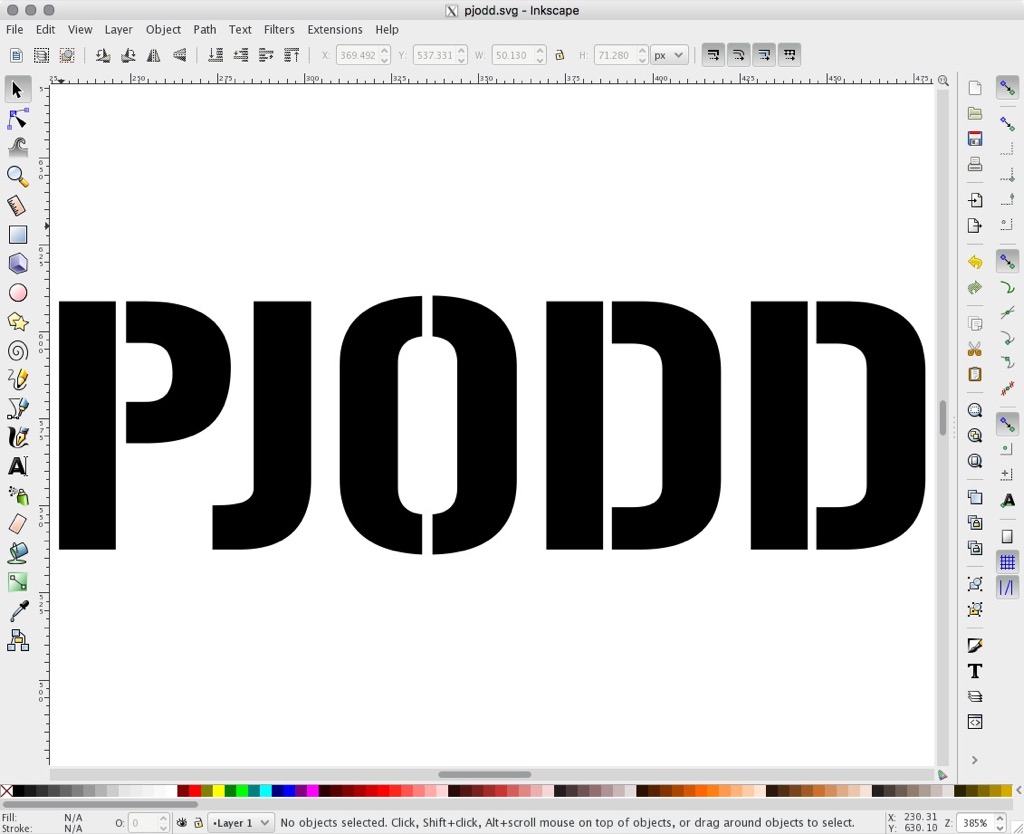
Before saving this as an SVG file, I selected the text and converted it to a path with Path > Object to Path from the menu.
Then I saved the file, and the result was pjodd,svg.
Next, I went to Tinkercad.com and created a new design; I dragged a box onto the canvas, and made it 8cm by 5cm, which is the size Karl said would work best. I adjusted the depth of the box to be 1.2mm high, which seemed about right for a stencil.

Next, I imported the SVG file with the text PJODD into the canvas, and sized it to fit within the 8cm by 5cm box, and to be the same 1.25 mm high:

I selected the PJODD object, and converted it from being solid to being a hole, and then grouped it with the box to “cut a hole” in the box.

I realized it made more sense to have the PJODD at the top of the block, to allow me to build in a handle to allow it to be easily placed and held, so I used the undo feature of Tinkercad to go back a few steps, re-positioned the PJODD, and re-grouped, to produce this:
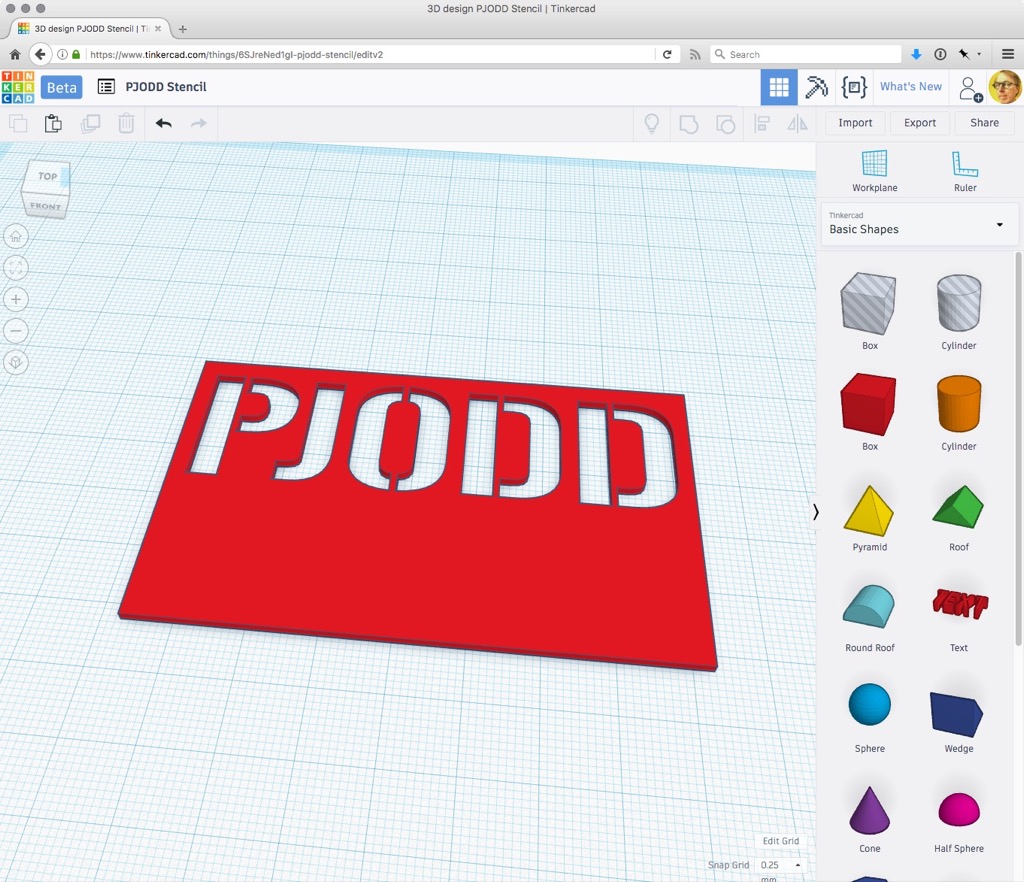
I added a box for a handle, and then used a half-sphere, rotated 90 degrees and turned into a hole, to create a divot to make it easier to hold:
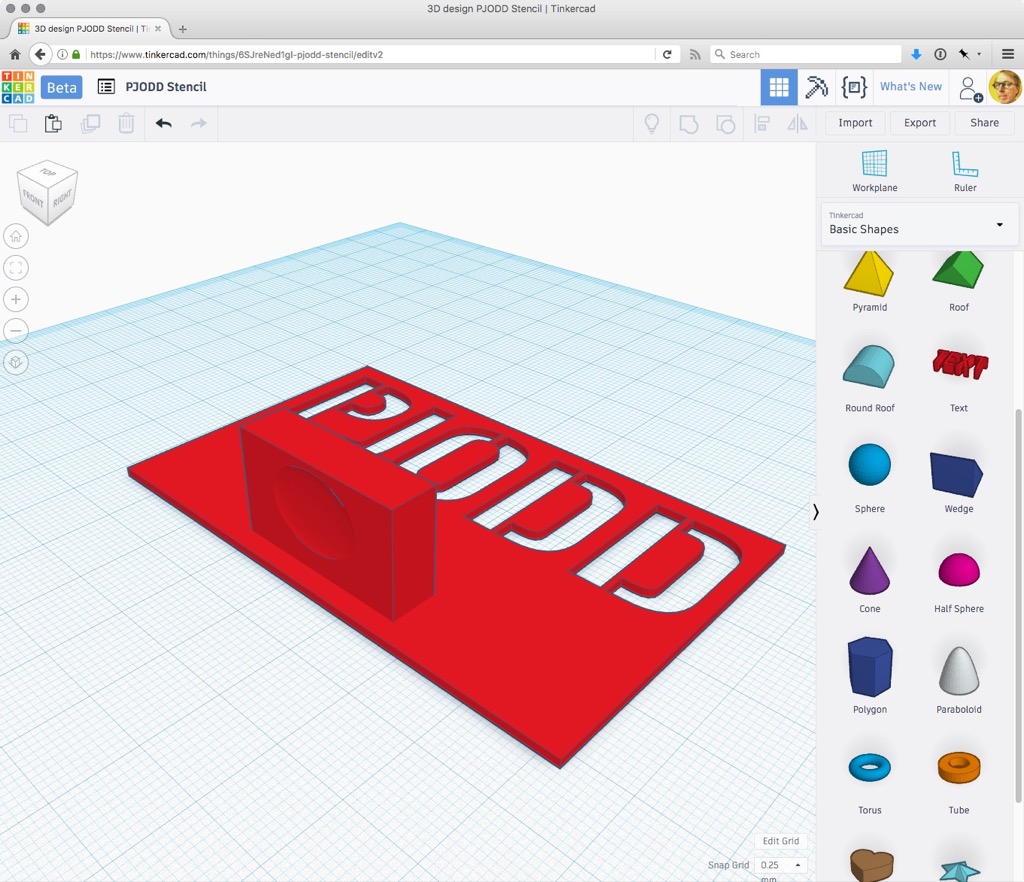
Here’s the finished object, ready for tinkering by others, in Tinkercad.
With everything set as I liked, I exported the object from Tinkercad as an STL file, pjodd.stl, and loaded this into Cura for slicing:
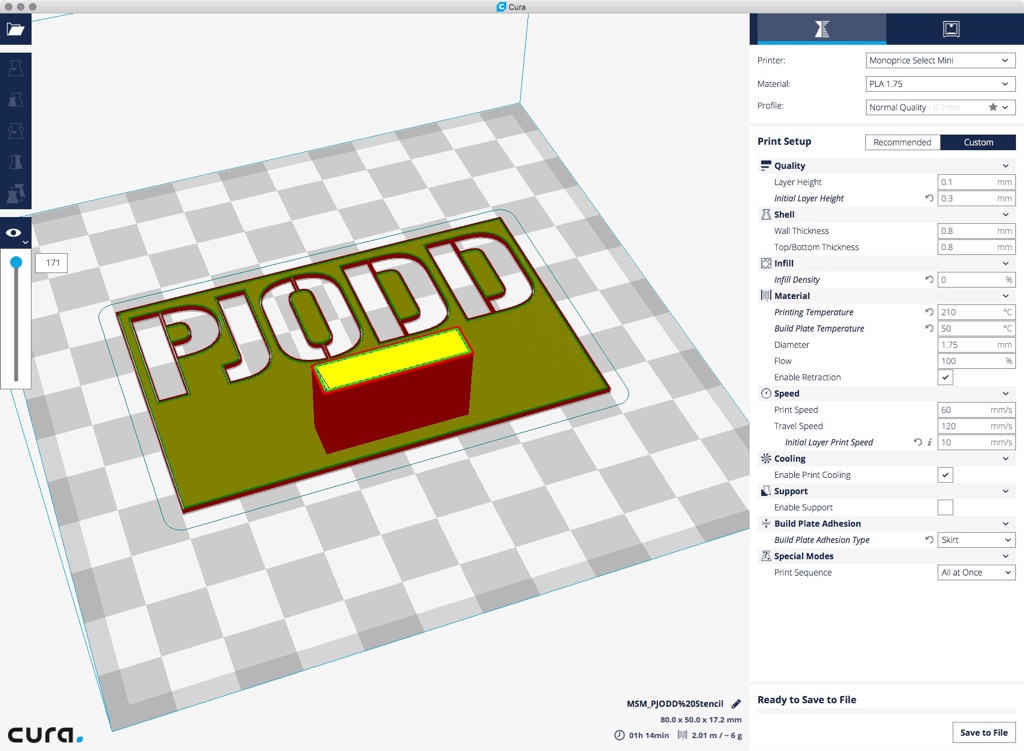
I adjusted a few of the settings in Cura–selected a “skirt” instead of a “brim” or “raft”–and then exported as a G-code file, pjodd.gcode.
I set the file to print on my Monoprice Select Mini; starting out it looked like this:
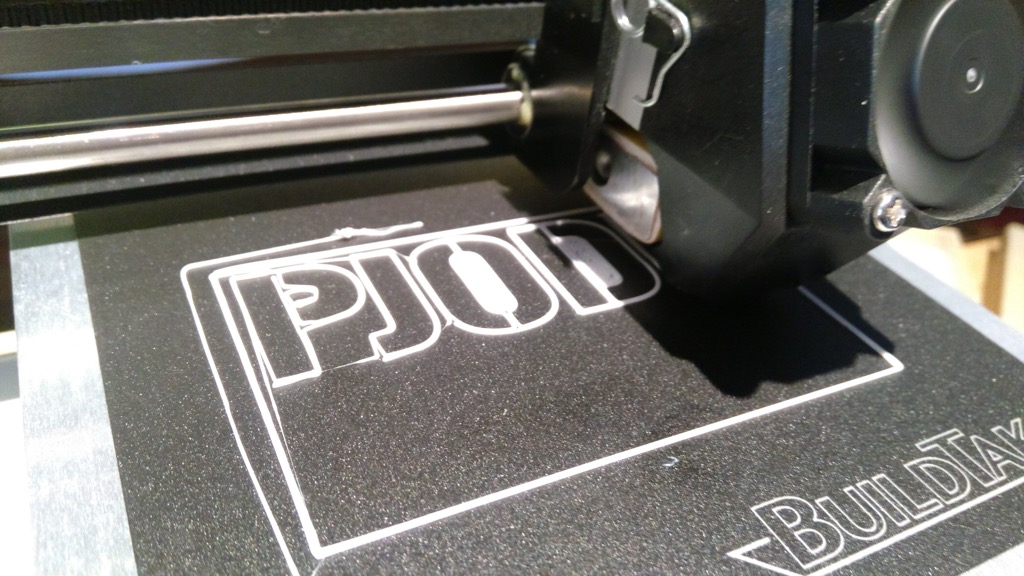
When it was finished, 90 minutes later, it looked like this:
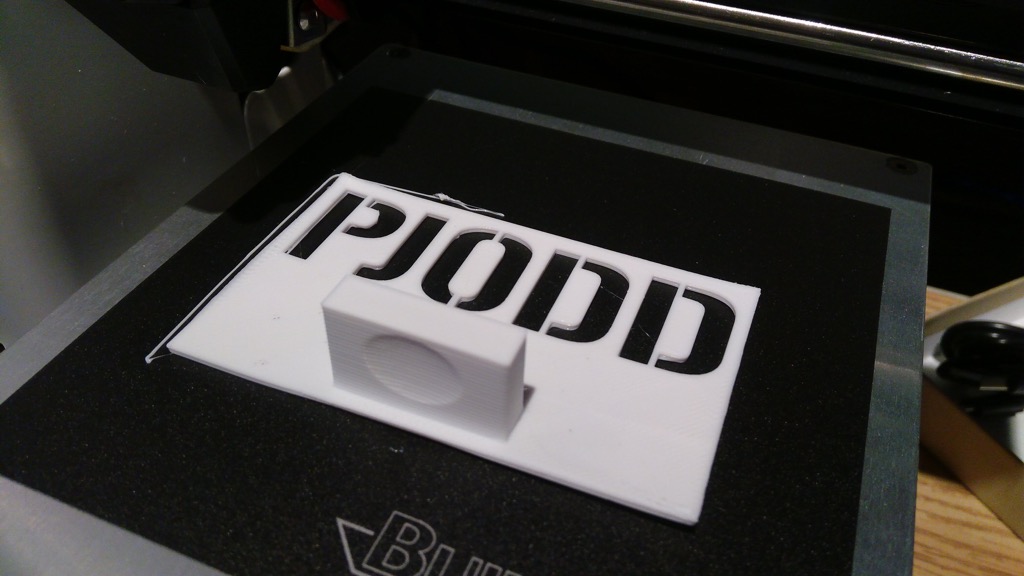
It’s hard to see in that photo, but there was some warping of the object at the edges that I may have been able to mitigate if I’d printed a “raft” underneath.
You get a better sense of its “stencilness” in profile:
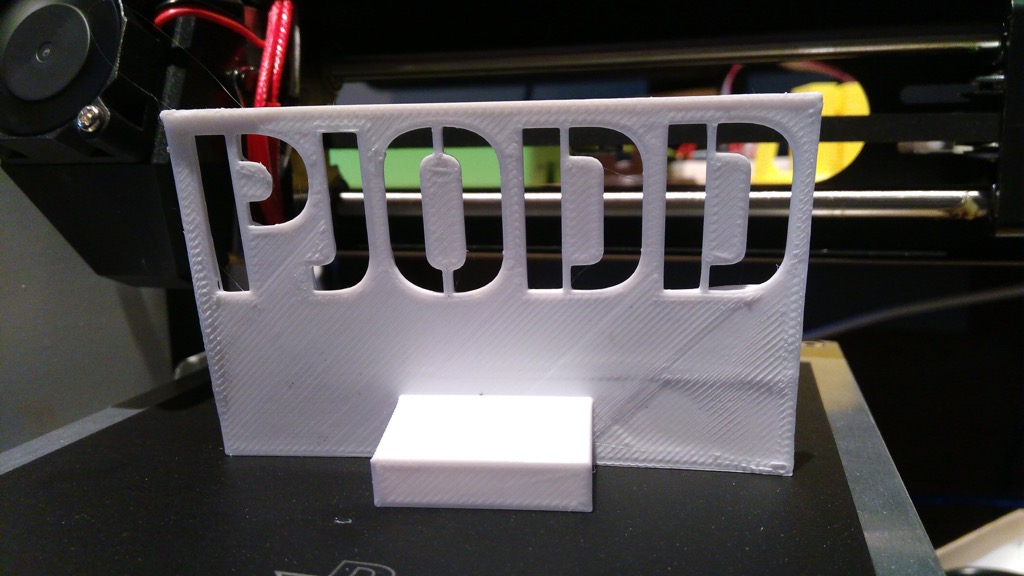
What good is a stencil if you don’t try it out in the real world! So I fashioned a crude “mask” around the finished stencil to allow me to spray paint through it: I cut a hole in a piece of card stock, and masking taped the stencil to the back of it:
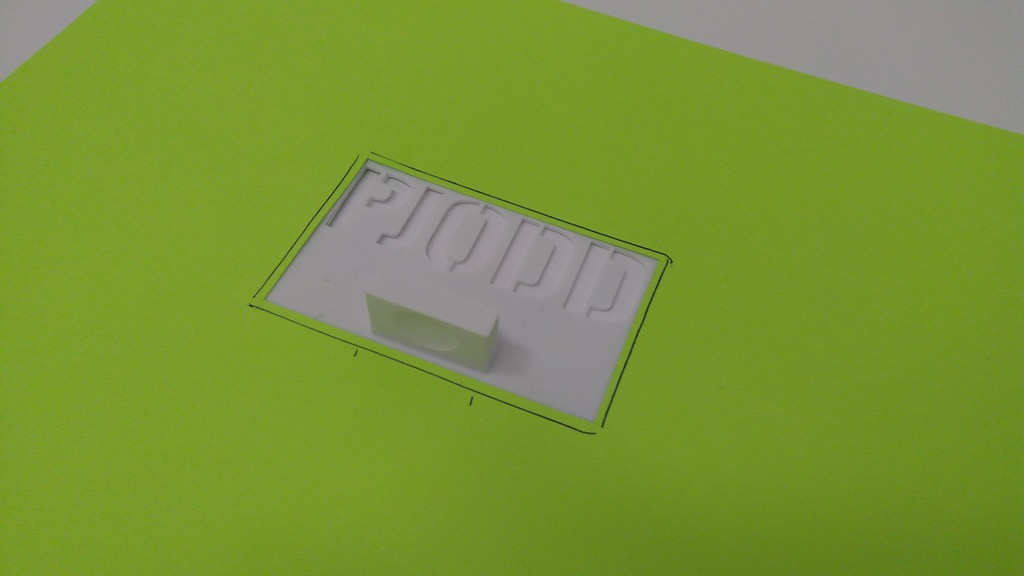
I dug some spray paint out of the bowels of The Guild and gave it a go, spraying lightly across with 2 passes from a height of about 6 inches:
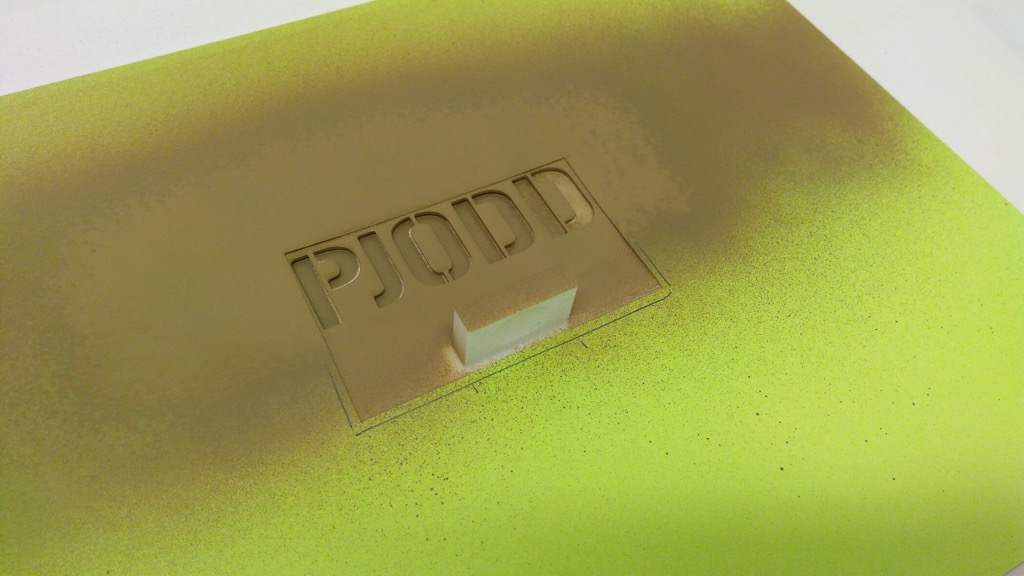
The result was not entirely unpleasing:

So I think we can call that at least a partial win.
Some things I’d do differently:
- The stencil doesn’t actually need to be as thick as it is; I’d say that I could print it 1/2 to 3/4 as thick and it would still hold together and stand up to multiple uses.
- I’d print the “base” around the stencil about 1cm larger in all directions to allow it to be more easily masked with tape on a paper base.
- I’d print a “raft” under the object on the 3D printer (this is a setting in Cura) to mitigate the warping; this would allow the stencil to be more flush against the item being painted and would cut down on some of the “paint shadow.”
- The “handle” doesn’t need to be as substantial as it is, at least not for spray painting; it would, I think, be useful for sponge-painting through the stencil, as you’d want a way to hold it in place securely. But for spray painting, all that’s really needed is a tiny little handle to pick it up with.
That all said, I’m not entirely sure that 3D printing is the best way of creating the stencil in the first place; alternatives:
- The Cricut machine, used by many in the scrapbooking and crafting communities, seems like it might be a better fit; here’s an example of someone using a Cricut-created stencil on a similar project. These machines are common enough that it’s likely that a friend or colleague within a few degrees of separation has one that you could borrow (or that they’d cut something on for you).
- Another alternative is to screen print the PJODD; Lumi.com sells low-cost ($15US) custom frameless silk screen kits that might do a better job for less money and less hassle (I’ve ordered from them before; they’re good people).
Even if 3D printing isn’t the best way to go, it did have the advantage of being something I could take from conception to testing in only a couple of hours, and I learned a lot in the process.
Karl, your move.
Four years ago, with the help of my friend Don Moses, I designed, and then had printed on his 3D printer, a “desk hole filler”.
I went on to design a second iteration, with USB female jack, a few weeks later.
One of my reasons for wanting to acquire a 3D printer in-house is that, based on years of experience in the digital realm, I’ve found that having to go out of house for parts of the toolchain, whether it’s servers or parts or 3D printing, can be an insurmountable bottleneck. More steps slows down innovation.
So whereas Don was extremely generous with his time and printer, you can only get so far if the printer is a few miles away and dependent on someone else’s good graces.
And so, by way of iterating on this project, I decided to print a desk hole filler here on my new Monoprice Select Mini, just to get a refreshed baseline sense of the project, with an eye to modifying the design now that I can crank out new versions on a whim.
To start, I printed what amounts to exactly the same thing that Don last printed out for me, minus the USB text (which was printed backwards in any case); you can grab the model from Tinkercad if you want to play along.
It took 2 hours and 39 minutes to print, and looked like this when it was done and before I removed the brim:
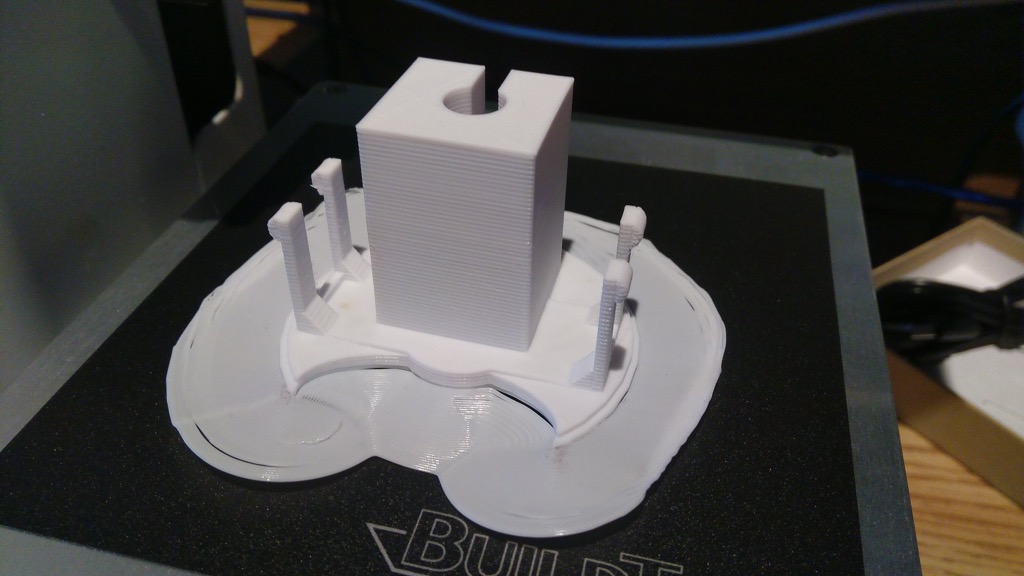
Once I’d removed it from the base, trimmed off the brim, and inserted it into my desk, it looked like this:
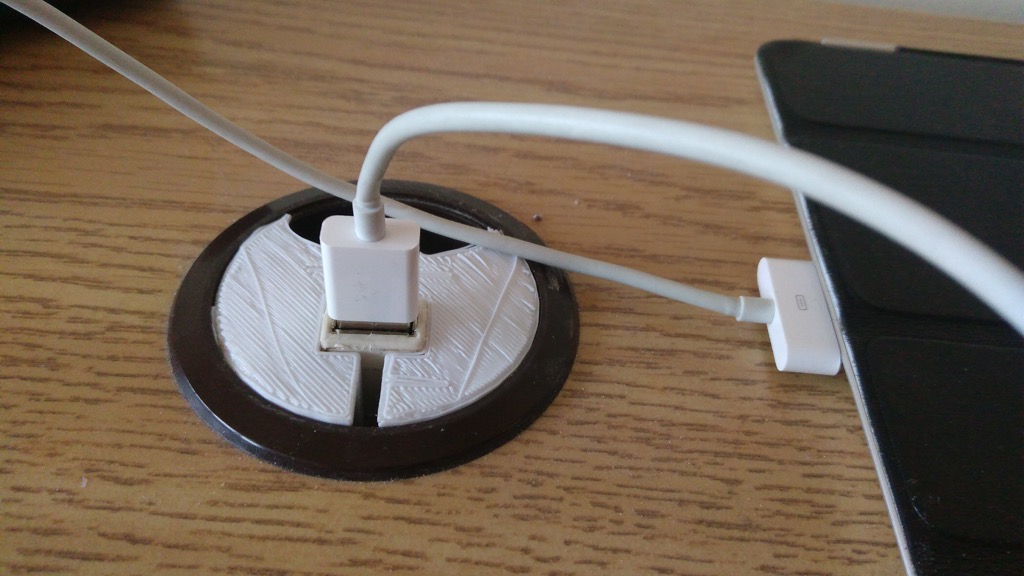
The USB female jack is the end of a USB cable that slots into the desk hole filler, runs down through the bottom of it, and then runs across the bottom of my desk and up through the opposite end where it plugs into a USB hub for power.
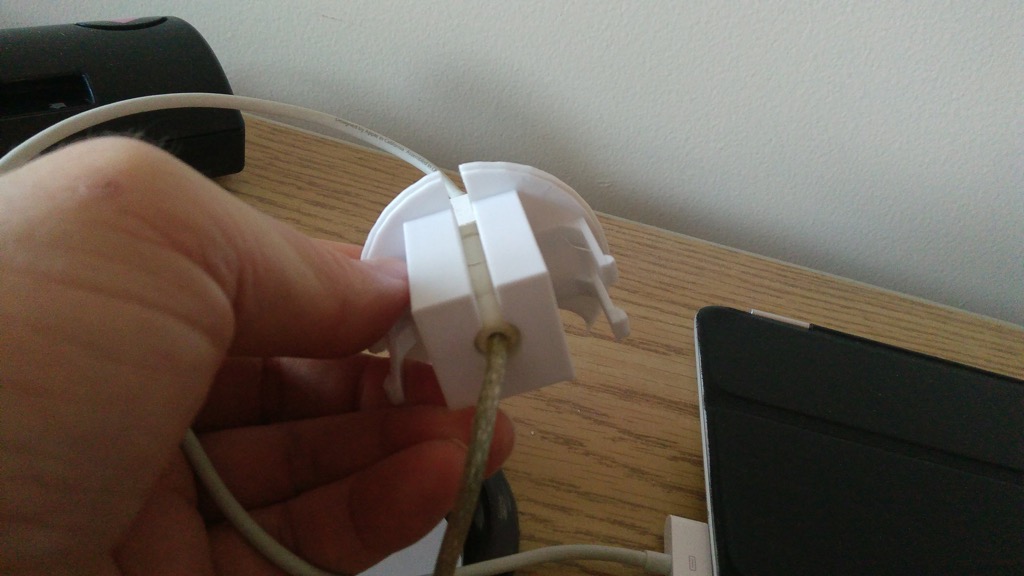
Compared to the version that Don last printed for me in 2013, I think (by chance rather than skill) I got the leg “springiness” right, as they had the right amount of give on insertion, and didn’t snap off. Don’s “face” was much smoother than mine, which is all ugly and stringy and rough-looking, so I’ve got that to iterate on to start.
 I am
I am